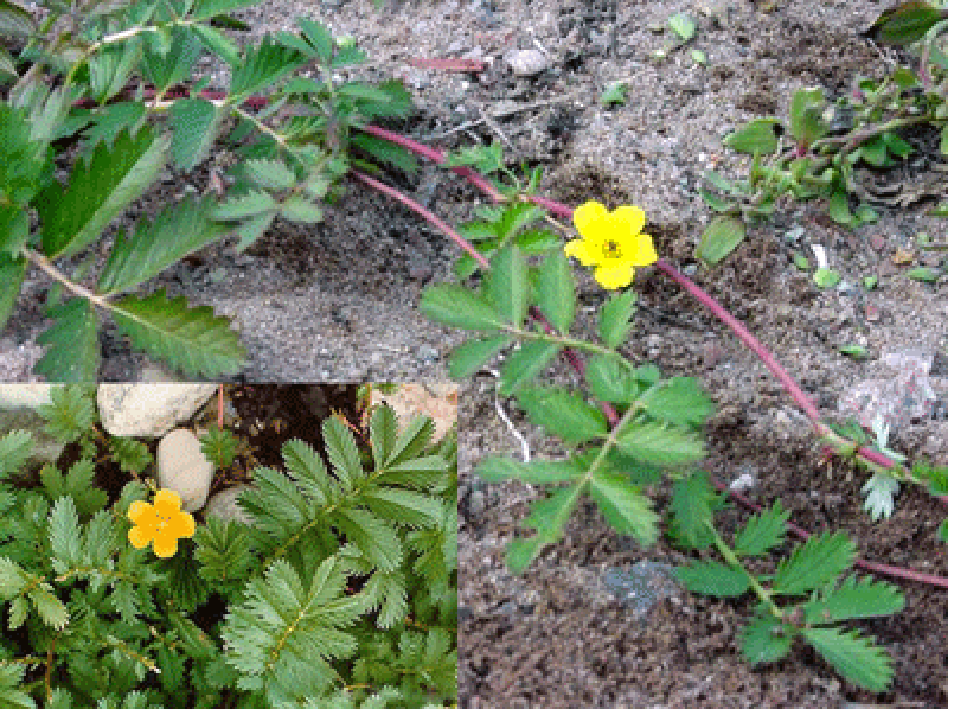 Silverweed (Argentina anserina) and silverweed runners
Silverweed (Argentina anserina) and silverweed runnersin flower.
Welcome to the summary page for FabulousFusionFood's Cook's Guide entry for Silverweed along with all the Silverweed containing recipes presented on this site, with 1 recipes in total.
This is a continuation of an entire series of pages that will, I hope, allow my visitors to better navigate this site. As well as displaying recipes by name, country and region of origin I am now planning a whole series of pages where recipes can be located by meal type and main ingredient. This page gives a listing of all the Silverweed recipes added to this site.
These recipes, all contain Silverweed as a major wild food ingredient.
Silverweed, Argentina anserina is a creeping flowering perennial palnt of the family Rosaceae (rose family). It is is a low-growing herbaceous plant with creeping red stolons up to 80 cm long. The leaves are 10-20 cm long, evenly pinnate into in crenate leaflets 2-5 cm long and 1-2 cm broad, covered with silky white hairs, particularly on the underside. These hairs are also present on the stem and the stolons. These give the leaves the silvery appearance from which the plant gets its name.
Silverweed is most often found in sandy or gravelly soils, where it may spread rapidly by its prolific rooting stolons. It typically occurs in inland habitats and is frequently seen near the base of sandy hedgerows. The extent of this plant's habitat is truly staggering and it can be found from Lapland to New Zealand and China to Chile.
The roots of the plant are edible and can be eaten raw or boiled or baked. It is though that the plant was cultivated during ancient times and that the root was ground into flour after baking. It has also been used as a drought food as it is both drought tolerant and very common in the wild.
The plant's Latin name of Argentia anserina is derived from 'silver' and "of the goose" (Anser), either because the plant was used to feed them or because the leaves reminded of the bird's footmarks.
This is a continuation of an entire series of pages that will, I hope, allow my visitors to better navigate this site. As well as displaying recipes by name, country and region of origin I am now planning a whole series of pages where recipes can be located by meal type and main ingredient. This page gives a listing of all the Silverweed recipes added to this site.
These recipes, all contain Silverweed as a major wild food ingredient.
Silverweed, Argentina anserina is a creeping flowering perennial palnt of the family Rosaceae (rose family). It is is a low-growing herbaceous plant with creeping red stolons up to 80 cm long. The leaves are 10-20 cm long, evenly pinnate into in crenate leaflets 2-5 cm long and 1-2 cm broad, covered with silky white hairs, particularly on the underside. These hairs are also present on the stem and the stolons. These give the leaves the silvery appearance from which the plant gets its name.
Silverweed is most often found in sandy or gravelly soils, where it may spread rapidly by its prolific rooting stolons. It typically occurs in inland habitats and is frequently seen near the base of sandy hedgerows. The extent of this plant's habitat is truly staggering and it can be found from Lapland to New Zealand and China to Chile.
The roots of the plant are edible and can be eaten raw or boiled or baked. It is though that the plant was cultivated during ancient times and that the root was ground into flour after baking. It has also been used as a drought food as it is both drought tolerant and very common in the wild.
The plant's Latin name of Argentia anserina is derived from 'silver' and "of the goose" (Anser), either because the plant was used to feed them or because the leaves reminded of the bird's footmarks.
The alphabetical list of all Silverweed recipes on this site follows, (limited to 100 recipes per page). There are 1 recipes in total:
Page 1 of 1
| Rainkohl und Grünkern-Suppe (Nipplewort and Green Spelt Soup) Origin: Germany |
Page 1 of 1